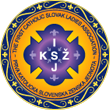Polish Traditions
- Emblems and Symbols of Poland
- National and Folk Dances of Poland
- Polish Culinary History and Traditions
- Polish Art of Wycinanki
- Polish Easter Traditions
- Polish Contitution Day May 3rd
- Corpus Christi – Boze Cialo
- Lajkonik
- Bociany/Storks
- Eve of St. John’s Day – Noc Swietojanska
- Matki Bozej Zielnej – Our Lady of the Fields
- Dozynki – Harvest Festival
- November in Poland
- Polish Advent Traditions
- Polish Traditions – Kolednicy-Carolers
- Polish Christmas Traditions
- Polish Wedding Traditions
EMBLEMS AND SYMBOLS OF POLAND
National emblems are the symbols that countries around the world use to represent what is unique about the nation, reflecting different aspects of its cultural life and history. They intend to unite people by creating visual, verbal, or iconic representations of common values, goals, or history. These symbols are often rallied around as part of national and patriotic celebrations and are designed to be inclusive and representative of all the people of the land. Within countries, regions and cities also often have their own flags, coats of arms, and mottos to reflect local pride and history.
COAT OF ARMS—THE WHITE EAGLE
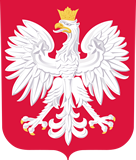
Poland’s coat of arms has been used for centuries and incorporates a white eagle capped with a gold crown. The legendary founder of Poland, Lech, while exploring the region for settlement over a thousand years ago, spotted a large, soaring white eagle above its nest with the setting sun and a red sky in the background, and was so moved by the symbolic sight that he decided to build a town there. “Nest” (gniazdo in Polish) is the origin behind the name of the first capital of Poland, Gniezno, and the eagle became a symbol of the state that evolved from that original settlement. The Polish eagle, with its wide spread wings and pointed talons on a red shield, has changed design several times, and during the communist period it was even deprived of its crown. The white eagle was triumphantly recrowned after the fall of communism in 1989 and reincorporated into the official national flag.
FLAG OF THE REPUBLIC OF POLAND
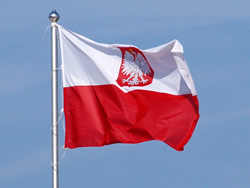
After the partitions of Poland in the late 18th century, patriots needed an easily recognizable symbol and started to use the red and white flag derived from the colors of the coat of arms. It consists of two horizontal bands of equal length and width, the upper white, the lower red. Officially, the flag was introduced in 1831, but even earlier, in 1792, the participants of the first anniversary of the Polish Constitution wore white and red clothes as a symbol of their patriotism. Banished by Russian tsars, the bi-color flag was reinstated in 1918 after Poland regained its independence. Nowadays, the flag can either be represented with the two plain white and red bands or a variant with the crowned eagle coat of arms placed in the center of the upper white band, the latter version reserved for official and naval uses, and abroad (embassies and consulates). During the communist period there were many restrictions on the use of the Polish standard where the unofficial flying of the colors was considered an act of resistance against the regime. As a consequence, the flag was often displayed during strikes and the Solidarity movement incorporated the flag into its famous emblem. Regular flag-flying days in Poland are: May 1st (May Day), May 2nd (Polish Flag Day), May 3rd (Constitution Day), August 15 (Polish Armed Forces Day), September 27 (Polish Underground State Day), and November 11th (Independence Day).
POLISH NATIONAL ANTHEM
Adopted in 1927 as the national anthem of the Republic of Poland, Jeszcze Polska nie zginela (Poland Is Not Yet Lost), is set to an unattributed mazurka composition with lyrics by Józef Wybicki (1747-1822), written in 1797 while he was stationed in Italy with Polish Legions under the command of General Jan Henryk Dabrowski, fighting in the Napoleonic Wars for Poland’s independence during the Partitions. The lively melody and stirring words capture the spirit of the indomitable Polish nation.
MOTTO
While Poland has no sanctioned motto of state, there are some phrases that recur in popular and semi-official usage. The most common are: Za wolnosc Nasza i Wasza (For Our Freedom and Yours) and Bóg, Honor i Ojczyzna (God, Honor, and Country).
WARSAW MERMAID
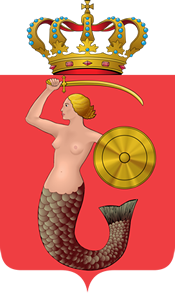
Perhaps no country is more enamored with the mermaid (syrena), part woman, part fish, than Poland, whose legendary Syrena adorns the coat of arms of its capital city of Warsaw, and where a majestic Syrena statue (1855, Konstanty Hegel) forms the centerpiece of the Old Town Market Square. This is not the only mermaid in Warsaw. There are numerous striking versions of the Syrena throughout the city.
For centuries, the ancient Polish legend of the mermaid has been a defining part of Polish culture and folklore. As post-war Warsaw lay in ruins around her, the Syrena statue stood unscathed, defiant, miraculously spared from the ravages of war. The origin of the imaginary figure is not fully known. It is said that one of the sea god Triton’s daughters swam in from the Baltic Sea along the Wisla River and stopped on the riverbank near the Old Town of Warsaw to rest. She found the place so admirable that she decided to stay. Local fishermen came to admire her beauty and listen to her lovely voice. She, in turn, promised to guard the fishermen.
As the myth grew in the imagination of the citizens, the Syrena assumed a powerful silhouette as the protectoress of the city, boldly armed with sword and shield to safeguard the residents from invaders. Her defiant stance has been interpreted in myriad incarnations—lending her myth in naming theaters, shops, and cafes; inspiring musical compositions, tales and plays; appearing in sculpture, on coins, postage stamps, and souvenirs; utilized in commercial applications promoting tourism, as well as a range of products, from sweets to the infamous Soviet era mini automobile named Syrenka. Through all her manifestations, the Mermaid of Warsaw soars as a proud symbol above the capitol and the nation.
NATIONAL AND FOLK DANCES OF POLAND
There are five national dances of Poland—dances that are known and beloved throughout the country and performed in all parts of Poland in different variations. They are the Polonaise, Mazur, Kujawiak, Krakowiak, and Oberek. In addition to the five national dances, there are also many regional dances that come from the Podhale, Lublin, Rzeszow, Beskidy, Silesia, Warmia, and Kaszuby, as well as other regions and towns of Poland.
The Polka, which is often associated with Poland and danced at Polish weddings and other celebrations, is not formally a national or folk dance of Poland. It actually originated in Bohemia, now part of the Czech Republic, although it is performed with gusto, both in Poland as well as in Polish immigrant communities throughout the world. The Polka has an especially fervent following among Polish Americans and there are many Polish polka bands that enjoy great popularity in the U.S.
Polonez
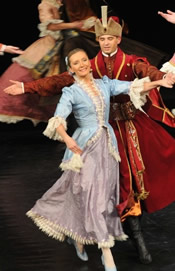
The Polonaise or Polonez, evolved from a Polish dance called the Chodzony (walking dance) in the 15th century. As one can infer from the name, the dancers walk gracefully and slowly around the dance floor, taking deep bows in time with the music. The Polonaise was embraced by the royalty and nobility in Poland, and eventually spread to the courts of other European countries, where it gained great popularity, further consolidated by Frederyk Chopin, who composed and performed a number of Polonaises as part of his repertoire, adding to the acceptance of this music form and dance form in royal halls all across Europe. Today, the Polonaise is danced at all formal balls and dances in Poland, and is an important part of debutante balls and dances organized by Polish immigrants around the world as well. It is considered to be a dance of the nobility and not a true folk dance, like the other national dances of Poland.
Mazur
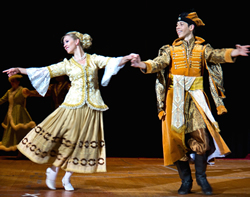
This dance originated in the Mazowsze region of central Poland. First popular with peasants in different regional versions, it was eventually adopted by Polish nobility and became a national dance. The Mazur also became very popular in European courts under the French name of Mazurka. The quick and light rhythm of the Mazur is well known from the Mazurkas composed by Frederyk Chopin, who contributed to its international popularity, much like he had done with the Polonaise.
Kujawiak
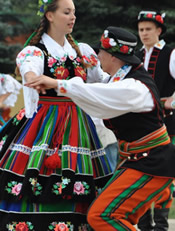
The Kujawiak has its origins in the Kujawy region in north-central Poland. It is a simple dance with slow cadences, performed with much dignity and grace. It first appeared in the mid-19th century and quickly spread throughout Poland, due to its beautiful music and slow, elegant, and romantic pace. Dancers take deep bows, extending their legs and arms, and move slowly and gracefully, in time with the music. The calm and lyrical rhythms of the dance are said to reflect the beauty and calm of the Kujawy landscape.
Krakowiak
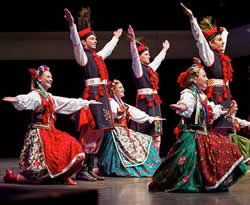
Kraków is well known not only as the old royal capital of Poland, but also as a vibrant center of folklore, history, culture, and the arts. Elements of the past appear in the Krakowiak, with the dancers often arriving on the stage in a horse-drawn cart. Horses are beloved in this southeastern region of Poland, and there is a familiar galloping step prevalent in the dance. The Krakowiak is performed by couples, with one leading pair who directs the flow of the dance, and the men often address their partners in song, with humorous ditties and comments. The men’s costumes are unique, featuring striped red and white pants, long blue vests, with peacock feathers in their caps and metal rings in their belts. Women wear flowered skirts, white aprons, embroidered vests with flowing ribbons, and flowered wreaths. This is the most beloved and patriotic of the Polish national dances.
Oberek
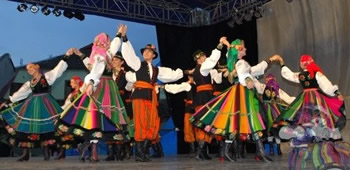
Oberek, also known as Obertas, is the most acrobatic of the Polish national dances. It originated in the villages of Mazowsze in central Poland. The name Oberek is derived from the verb “obracac”, which means to spin. The name reflects the fast tempo, circular movement, and whirling character of the dance. It includes kneeling, heel-clicking, jumping, stamping, double-stamping, and lifting of the partner (performed by both men and women). It is a rousing and vivacious dance, much beloved by audiences of all ages.
Góralski
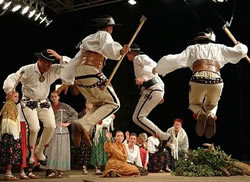
This is a regional dance, originating in the muntainous regions of southern Poland and the foothills of the Tatras. Also known as the Zbojnyczny, the Gorlaski showcases amazing acrobatics performed by the male dancers, who leap high into the air, punctuating their jumps with their wooden walking sticks topped with metal heads. The male dancers’ costumes are made of white wool, richly embroidered, and they wear special leather moccasins, which are typical for this region of Poland. The women wear flowered skirts, embroidered vests, and flowered wreaths. The Goralski is always a showstopper in any performance of Polish folk dancing.
NATIONAL DANCE ENSEMBLES OF POLAND
Mazowsze Ensemble
Founded by government decree in 1948 to preserve the richness of Poland’s folk traditions, Mazowsze is the official national dance ensemble of Poland and one of the largest artistic folk song and dance troupes in the world today. Initially created and inspired by Poland’s national dances, folk songs, chants. and traditions of the central region of Poland, Mazowsze, its repertoire quickly expanded to include and preserve the folklore of many other regions of Poland as well. Today, the ensemble performs over 42 versions of Polish songs and dances to international acclaim. Its performances have been viewed by millions all around the world and continue to be audience favorites, wherever they appear.
Slask Ensemble
Founded in 1953 as a regional dance ensemble, Slask originally focused on the folk traditions of Silesia, Cieszyn, and the Beskids in southwestern Poland. Due to its popularity, however, its repertoire was soon expanded to include the songs and dances of all of Poland’s regions and quickly gained international acclaim, along with the Mazowsze Ensemble, as a national dance troupe. Slask has performed over 6,000 shows for over 20 million people worldwide to date.
POLAND’S CULINARY HISTORY AND TRADITIONS
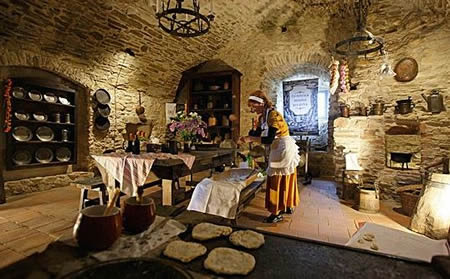
Poland as a nation has existed for over 1000 years, but it is hard to find historical sources and notes about its cuisine and eating habits that date that far back. We do know some facts about Polish (and European) cooking traditions that go back to the Middle Ages … and we also know about the first cookbook published in Poland in 1682. It was called “Compendium Ferculorum albo zebranie potraw” or “A Collection of Meals” by Stanislaw Czerniecki, master chef to the aristocratic Lubomirski family.
Polish cuisine in the Middle Ages was based on dishes made of agricultural produce (millet, rye, wheat), the meat of wild animals and wild birds, some farm animals and poultry, as well as fruits, herbs, mushrooms, and local spices. But it was known above all for the abundant use of two ingredients – salt from the many regional mines and the ever-present buckwheat groats (not a wheat product). Beer and mead were the most popular drinks at the time, but slowly, expensive wines, imported mainly from Silesia and Hungary, appeared as well. Medieval chronicles describe Polish cuisine as very pungent, using large amounts of salt, meat, and groats, with the most popular local spices being pepper, nutmeg, and juniper. Thanks to close trade relations between Poland and countries of the Orient, prices of imported spices were lower in Poland than in many other European countries and were introduced to the local diet more quickly than in other parts of the continent.
Geographical and political factors had a strong influence on Polish cuisine through the centuries. The country is located in a climatic zone that has cold and barren winters. For that reason, vegetables, fruits, meats, and fish that can be easily preserved and stored for three to four months played a central role. Food was preserved with the readily available fossil salt, as well as through smoking, drying, pickling, or slight fermentation. Other geographical features, like large areas of forests, also influenced the Polish diet. Sylvan fruits (wild strawberries, blueberries, currants, raspberries, and black raspberries) have always been popular and continue to be so today, as do wild mushrooms. The latter are unique to the cuisine of Poland and a few other Eastern European countries, as wild, edible mushrooms were undervalued in Western Europe. Mushroom-picking remains a time-honored Polish tradition to this day!
Through the centuries, game and venison were slowly replaced by pork, groats by potatoes, and cabbage and beets were added as staples of the Polish diet. Throughout history, Poland repeatedly lost access to the Baltic Sea because of wars and invasions. For this reason, Polish cuisine is dominated by freshwater fish from its lakes and rivers, such as carp and trout. Among saltwater fishes, herring, cod, and eel enjoyed the greatest popularity – and still do so today, as Poland once again has access to the Baltic Sea. Poland was always open to the migration of foreign refugees and this fact, combined with its constantly changing borders, introduced German, Hungarian, Jewish, Lithuanian, and Russian culinary influences to Polish cuisine.
Today, the components of historical Polish cuisine continue to be showcased in traditional recipes. They include cereal dishes (dumplings, kasha, pierogi), products of the forests (mushrooms, fruits, herbs), pork (including ham, bacon, lard, and sausages), freshwater fish, saltwater fish, wild game, baked goods (bread, cakes), fruit desserts, vodka, and many fruit liqueurs. Seasonings typical for Polish food are horseradish, dill, juniper, pepper, sour cream, and curd cheese. Among the most popular vegetables and fruits are beets, potatoes, cucumbers, cabbage, apples, cherries, and many types of wild berries. Also wild plants like sorrel, young beet greens, dandelions, and stinging nettles, and of course, wild mushrooms. Soups, both warm and cold, are also a staple of Polish cuisine, made from both vegetables (like beets, potatoes, and cabbage) and fruits (like cherries, plums, apples, strawberries, and blueberries). Poppy seeds, nuts, and dried fruits feature img src=”https://www.fcsla.com/district/pwaa/imagesprominently in many desserts, and dill pickles and sauerkraut are also favored dishes found on most Polish tables all year round.
Polish cooking falls into the general category of Central European cuisine, which favors pork, sausages, rye bread, cabbage, potatoes, dumplings, and mushrooms; also soups and heavy sauces; and a wide variety of baked goods. But in the 21st century, the trends of lighter cooking, vegetarian dishes, and modern variations on old recipes can be discerned and there are many restaurants, blogs, and cookbooks that offer modern takes on the oldest and most traditional Polish recipes that have been handed down over the centuries.
WYCINANKI: POLISH PAPER CUT-OUTS
Wycinanki, pronounced (vee-chee-nan-key), are Polish decorative paper cut-outs which are regarded by many as the most beautiful in the world. Wycinanki are made by hand in Poland, both by artists specializing in this art form, as well as by people who are not artists living in the areas known for them. The colored papers are cut with sheep-shearing scissors and were used to decorate the walls or ceiling beams in countryside cottages and/or given as gifts to family members and friends. The colorful cut-outs of flowers, circles, animals, birds, and stars with a symmetrical arrangement reflect a particularly high level of artistry.
In addition to the multicolored cut-outs of peacocks, roosters, and other birds, which are most traditional, there are also decorative scenes depicting special events throughout the year, such as Easter, Christmas, weddings, christenings, and harvest festivals, as well as folk costumes and scenes of ordinary life. Wycinanki were traditionally cut as a form of relaxation in rural areas of Poland in the long evenings of fall and winter, after the chores of the day were completed.
This folk art was passed down from generation to generation and, as it developed, it became quite competitive in many Polish towns and villages. New themes and ideas were introduced as the artwork became more detailed and intricate. The decorative cut-outs became popular throughout Poland in the middle of the 19th century, and remain a treasured form of Polish folk art through today.
Wycinanki vary by region. For example, wycinanki created in the Kurpie region are typically one color, while wycinanki from the Lowicz region are multicolored. Techniques include cutting, clipping, punching, tearing, and carving of paper, as well as nalepianki in which multiple layers are glued together.
You should be able to find a wycinanki workshop in your area by searching online; or you can watch the videos at the links below on You Tube. Wycinanki are a part of our Polish heritage that continues to be cherished and propagated in Poland and should be supported here in the U.S. as well. It is truly a fun activity to do with your children!
Meaning of Shapes in Wycinanki: birds-free spirit, freedom; rooster-guardian, new beginnings; peacock-beauty, showoff; heart-love; flowers-giving; tree-life, growth, change; circle-perfection with no beginning and no end
Meaning of Colors in Wycinanki: white-purity; red-love, celebration, triumph; black-commemoration, remembrance; green-hope, growth; blue-peace; yellow-jealousy, envy; orange-happiness; purple-imperial, regal; grey-slumber; brown-strength
Links:
POLISH EASTER TRADITIONS
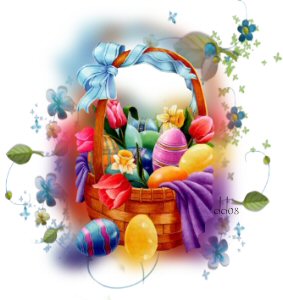
Polish Easter traditions are as old and beautiful as Polish Christmas traditions and they require just as much elaborate preparation. These traditions celebrate not only the central mystery of the Catholic faith, the Resurrection of Jesus Christ, they also celebrate the coming of spring and the long-awaited rebirth and renewal of nature after the long, dark months of winter. The Polish name for Easter is Wielkanoc, which means Great Night-the night from Holy Saturday to Easter Sunday-when the miracle of the Resurrection took place.
Lent or Wielki Post is the six-week period of religious preparation for Easter. Before the fasting that is a part of Lent, everyone enjoys one last week of merrymaking and good food. This is called Fat Week or Tlusty Tydzien. It starts on the Thursday before Ash Wednesday, when costume parties are held and millions of the famous jelly doughnuts called paczki are baked and consumed. In the United States, paczki are eaten on Fat Tuesday, also known as Mardi Gras, but in Poland these delicacies are a part of weeklong celebration leading up to Ash Wednesday.
On Ash Wednesday people go to church for ashes and they also cut pussy willow branches, called bazie or kotki and place them in water , in the hope that they will bloom by Palm Sunday. The six weeks of Lent, leading to Easter Sunday, are a time of fasting and prayer. Stations of the Cross and Gorzkie Zale are two religious traditions observed during Lent. Gorzkie Zale, which means Bitter Sorrows, are beautiful hymns or lamentations that are sung on Friday evenings and Sunday afternoons in Lent. These are ancient chants, retracing the Passion and Crucifixion, and their soulful notes ring out of all churches in cities and villages in Poland during Lent.
Palm Sunday begins Holy Week when preparations for Easter can start in earnest. Since palms do not grow in Poland, people take pussywillow branches to church to be blessed by the priest on Palm Sunday, or sprigs of colored straw. The branches and sprigs are then hung in houses, usually tucked behind a holy picture, to bring health and prosperity to the household during the coming year.
Holy Week, Wielki Tydzien, includes spiritual and other preparations for Easter. Homes are cleaned, curtains washed, and the baking and cooking begins. In olden times, ham and sausages were made and smoked at home, and bread and other pastries were baked from scratch. The baking tradition continues today and tall airy babkas, flat colorful shortbread cakes called mazurki, and rich creamy cheesecakes or serniki are lovingly prepared. Each housewife wants to have a large selection of homemade pastries to place on her Easter table. Easter eggs, called pisanki, are also made during Holy Week.
On Holy Thursday, people go to church for a service that commemorates the Last Supper. The priest washes the feet of twelve parishioners and repeats the actions and words of Jesus Christ, starting the celebration of the Passion that will take place over the next three days. On Holy Friday, after 3 p.m., which is the time that Jesus died on the cross, each church sets up a tomb where the Holy Eucharist is placed as well as a statue of Jesus taken down from the cross. Parishioners stand guard at the tomb all night as people come and pray. Many people go from village to village and in the city from church to church to pray at the tombs, called groby. No baking is allowed on Holy Friday, but people spend time coloring Easter eggs and preparing baskets to be blessed in church on Holy Saturday.
The most colorful additions to Polish Easter baskets are the Easter eggs, called pisanki. There are many different names for Easter eggs in Poland, depending on the method that is used to make them. Click here to learn more about the many methods of making Polish Easter eggs. In addition to the eggs, a Polish Easter basket includes sausage or ham, bread, butter, salt, and horseradish. The eggs symbolize life, spring, and the Resurrection. Bread represents Christ, the bread of life. The sausage or ham represent abundance and God’s generosity. The horseradish represents the passion of Christ and salt symbolizes prosperity. Butter represents good will and the decorations of green sprigs, pussy willows, or daffodils represent joy. People all over Poland walk with their Easter baskets in hand to church on Holy Saturday-where a priest blesses them with holy water-and then they go straight home to try some of the blessed food, which tastes all the more delicious after weeks of fasting during Lent.
On Sunday morning, a beautifully laid table is prepared and covered with pisanki, ham, sausage, cold meats, salads and relishes, including cwikla, made with grated beets and horseradish, bread, babki, mazurki, and other pastries, and, in the center, a lamb made of butter or sugar, commemorating the resurrected Christ. No smoke was permitted on Easter Sunday so no warm food was served, other than zur, the traditional sour soup that is a must on the Easter menu. Easter Brunch is called Swieconka, which means blessed food, since many of the items served on Easter Sunday had been blessed in church on Holy Saturday. The Easter Brunch starts with the sharing of a blessed egg-everyone takes a piece of the egg from the head of the household as they exchange best wishes with one another.
On Easter Monday the water consumption in Poland shoots way up and this is due to an ancient custom that is still observed today, in villages and cities alike. It is called Smigus Dyngus or Wet Monday when people sprinkle each other with water on the day after Easter, or, in the case of young people, they don’t sprinkle but douse each other with buckets of water. Boys lie in wait to surprise young girls to see who can get whom wet first! In extreme cases, you might even be thrown into a stream of cold water with all your clothes on!
The custom of pouring water is an ancient spring rite of cleansing, purification, and fertility that is practiced all over the world, from Europe to China. In Poland it takes on a religious meaning since, according to legend, Prince Mieszko I, the first king of Poland, was married and baptized on Easter Monday in the year 966 AD. He had the entire nation of Poland christened on his wedding day as well, and Poland has been a deeply religious country every since, for over one thousand years.
Polish Easter Eggs – Pisanki
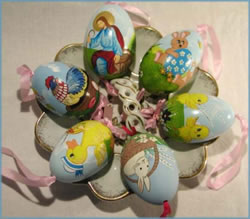
Eggs are a symbol of spring and rebirth all around the world, and they have also become the most enduring symbol of Easter and the Resurrection. In Poland, Easter egg-making has developed into a true art form and there are as many methods of making them as there are traditions and rituals associated with them. Easter eggs are called pisanki in Polish, which comes from the word pisac, which means to write. Designs are drawn or words are written on a hardboiled egg with a wax stylus, then placed in a dye. When the wax is scraped off, a white pattern is revealed on the colored egg.
Pisanki are usually prepared in Polish homes during Holy Week, especially on Holy Friday. On Holy Saturday, the colored eggs are placed in baskets, along with butter, bread, salt, horseradish, sausage, and ham, and taken to church to be blessed by a priest
Altough pisanka has come to mean Easter egg in Polish, it represents only one of the methods used to decorate eggs in Poland. Here are some of the most popular types of Easter eggs in Poland:
- Pisanki – eggs with wax patterns “written” or drawn on them, then dyed
- Kraszanki – solid-color eggs, dyed with plant materials such as beets, onion skins, and leaves
- Malowanki – hand-painted eggs
- Drapanki – solid-color eggs with a design scratched onto the surface
- Wyklejanki – eggs decorated with colored yarn
- Nalepianki – eggs decorated with paper cut-outs or straw
Sometimes, hollow eggs are used instead of hardboiled. The eggs can then be displayed all year long, ensuring good health and prosperity. The solid-color eggs were used for consumption; the decorated and hollow eggs would be saved from year to year. Once blessed in church on Holy Saturday, eggs were never thrown out, nor were the eggshells. Instead they would be buried in the garden or field as crops were sown, bringing good fortune and ensuring a good harvest. The water used in cooking Easter eggs was also saved and used to water fruit trees and to wash beehives. This was believed to result in sweet-tasting fruit and delicious golden honey.
On Easter Sunday, before Swiecone, the traditional Polish Easter Brunch, a blessed Easter egg is shared by the family, as Easter wishes are exchanged. Pets and livestock were given a blessed Easter egg to eat as well.
For Polish Easter Recipes, click here.
POLISH CONSTITUTION DAY MAY 3rd

Did you know that the Polish Constitution is the second-oldest Constitution in the world and the first Constitution in Europe? It was ratified on May 3, 1791, only four years after the American Constitution was adopted by the Constitutional Convention in Philadelphia in 1787.
Did you know that the Polish Constitution so enraged Poland’s super-power neighbors that they partitioned the country in an attempt to keep democracy from spreading beyond Poland’s borders? Russia, Prussia, and Austria divided Poland into three sections and ruled the nation for over 100 years.
Did you know that Poland has two national holidays? May 3rd Constitution Day and November 11th Independence Day. That was the day in 1917 when Poland’s Independence was reinstated by the Regency Council, after more than 100 years of partition by its neighbors.
CORPUS CHRISTI – BOZE CIALO
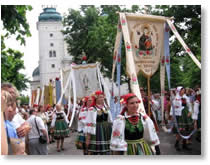
The feast of Corpus Christi (Body of Christ) or Boze Cialo is observed on the Thursday after Trinity Sunday all over Poland. Houses, doorways, and windows are decorated with greenery, flowers, and holy pictures and makeshift altars and shrines are built in the streets.
Traffic comes to a virtual standstill at noon as from every church in the country a procession leaves with people walking behind the priest who is carrying the Blessed Sacrament. Many of the people are dressed in their regional costumes. The colorful procession winds through the streets, stopping at the temporary shrines to sing and pray. The shrines are also decorated with branches and members of the processions pick twigs and leaves from them for good luck and happiness. Young girls dressed in First Holy Communion dresses scatter flower petals on the street in front of the priest while young boys carry incense. It is a day of celebration and prayer in all of Poland, as well as a national holiday.
LAJKONIK
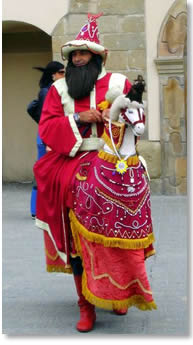
The legend of Lajkonik goes back to medieval times, when Poland was often invaded by Mongol tribes from the East. In 1241, the people of Krakow successfully repelled one such attack and this triumphant day is celebrated every year on the first Thursday after the religious holiday of Corpus Christi during the Lajkonik Festival.
Lajkonik has become one of the most beloved unofficial symbols of the city of Kraków. It is represented as a bearded man resembling a Tatar in a pointed hat, dressed in colorful attire, with a wooden horse around his waist. Some say that the legend originated in pre-Christian times when it was believed that in the spring a horse brought good luck and high crop yields. Later this was combined with the historical stories of a Mongol invasion that was warded off by the brave people of the city. Today, the Lajkonik Festival begins with a colorful parade of medieval dragons, knights, kings, and maidens, led by the Lajkonik who prances around chasing people with his mace. It is said that if he touches you with his mace, you will have good luck throughout the coming year! The parade starts at the Wawel Castle and ends in the center of town, in Market Square.
BOCIANY / STORKS
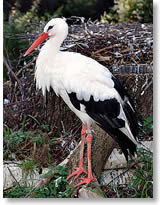
Nothing says spring in Poland more than the arrival of the beloved “bociek” or stork. You can see their large nests on rooftops, towers, chimneys, telephone poles, walls, haystacks, and on specially constructed nest towers. Storks are said to bring good luck and many homeowners will erect special stork ledges on their roofs to encourage them to nest there.
Poland is home every summer to over half of the 160,000 European storks thought to be in existence today. They are tall white wading birds, with long red legs and long red beaks. They play a colorful role in Polish fairy tales and folklore. They are much loved by young and old alike and they are considered harbingers of the weather, marking the warm months with their activities. Here are some folk sayings about storks in Poland:
- If storks arrive on St Joseph’s Day (March 19), the snows will soon melt away.
- On Annunciation Day (March 25), a stork will be in its nest to stay.
- On St Wojciech’s Day (April 23), the stork an egg will lay.
- On St. Bartholomew’s Day (August 24), the stork prepares to fly away.
The storks fly from Poland to Africa for the winter months with their young. Over 100,000 stork babies are hatched in Poland every summer. Storks really seem to love their adopted country of Poland!
EVE OF ST. JOHN’S – NOC SWIETOJANSKA
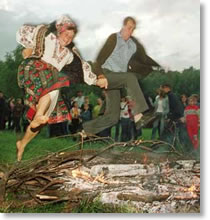
People have always celebrated the summer solstice. The shortest night of the year is a night of festivities and merry-making all across the world. In Catholic Poland, the celebration of this night was moved a few days to coincide with the eve of the feast of St. John the Baptist on June 24th. So the night that is celebrated with festivals in Poland is called the Eve of St. John’s and it falls on June 23rd.
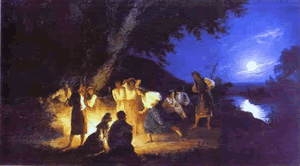
Traditions of the summer solstice focus on two of nature’s elements: fire and water. These elements symbolize male and female characteristics and the celebrations in Poland include the burning of huge fires by men and boys, who also danced around them and jumped through them, while girls made wreaths from flowers and herbs and floated them down the rivers and streams, sometimes adding burning candles to the wreaths.
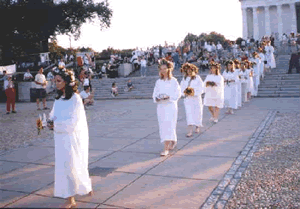
The men and women usually celebrated separately, the only communication between them being the floating of the wreaths (rzucanie wiankow). Girls hoped that the young man of their dreams would find their wreath and then fall in love with them.
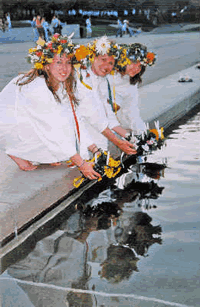
There is a Polish legend that says that the magical flower of the lowly forest fern (kwiat paproci) only blooms on this shortest night of the year. According to the legend, anyone finds this mysterious fern will be rewarded with great treasures. Fairy tales abound about young men who go off on this night, searching for the illusive fern flower.
Today, St. John’s Eve festivals and parties include music and dancing, fireworks, boat floats, and bonfires, with men and women celebrating together. In Warsaw and Krakow and in other smaller towns along the Wisla River, you can still see candle-lit wreaths floating down the river on the night of June 23rd.
MATKI BOSKIEJ ZIELNEJ – OUR LADY OF THE FIELDS
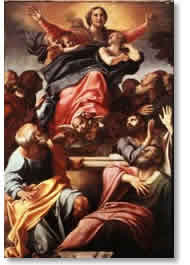
As summer draws to an end in Poland, the feast day of Our Lady of the Fields (Matki Boskiej Zielnej) is celebrated on August 15th. This is also the feast day of the Assumption of Our Lady. People bring to church great bouquets made from branches, herbs, vegetables, and wheat, interwoven with a few flowers from the fields and gardens, which are blessed by the priest. These bouquets are carried home and kept until the following year. When there is sickness in the household, the herbs are brewed and used for medicinal purposes, not only for the people, but for the livestock as well. Wreaths are made on this day by young girls and also brought to church to be blessed and then they are proudly worn to attract young men during the picnics and festivals that follow the ceremonies in church.
DOZYNKI – HARVEST FESTIVAL
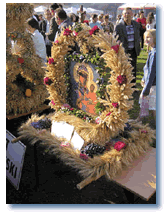
The Poles do not celebrate Thanksgiving in November the way we do in the United States. They celebrate the end of the harvest and thank God for the bounties of the land in September, as summer turns to fall and as the last fields are mown and harvested.
The symbol of Dozynki or the Harvest Festival is a large wreath made of a number of grains, the ones considered most important to the harvesters, usually wheat and rye. The wreath was made in the shape of a domed crown and decorated with flowers, ribbons, hazelnuts, and the fruit of the mountain ash tree. Holy pictures or icons were sometimes added (see photo).
The wreaths were made by farmers and landowners and brought to church to be blessed during the Harvest Mass. Everyone dressed in their finest folk costumes for the Mass and young maidens vied to be the ones selected for the honor of wearing a smaller version of the dozynki wreath on their heads. A procession accompanied the wreaths to church, which were either carried or placed in horse-drawn wagons, also decorated with ribbons and greenery. After Mass, a harvest feast was prepared and everyone joined in the celebrations that sometimes lasted for a few days. Music, singing, and dancing accompanied the festivities, as everyone rejoiced that the work of the harvest was done and that the food and grains were now in storage for the long winter season ahead.
The dozynki wreaths were taken home after the celebration and hung in a prominent place in the home, such as in an entrance hall, above a chest of drawers, or above the door of the main living room as a symbol of prosperity
NOVEMBER IN POLAND
The biggest holiday in Poland of the autumn season is All Saints’ Day called Wszystkich Swietych, celebrated on NOVEMEBR 1st.
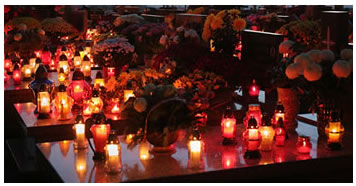
All Saints’ Day is a holy day which has been celebrated in Poland and the rest of the Catholic world for many centuries. All Saints’ Day is a national holiday in Poland, and a day when people visit the graves of loved ones and place candles and flowers on their graves. Abandoned graves are also decorated with candles and flowers. If a family has moved away or no family members are able to be present, neighbors will make sure that no grave is forgotten. On this day, all of the dead are to be remembered and honored. The special votive candles, which can burn for many hours, are placed on the graves so that departed souls can find their way through the darkness and flowers, usually mums, are placed so that the dead know that they live on in the memories of the those they left behind. Cemeteries are lit by many hundreds of these candles and at night they can be seen glowing from long distances as darkness descends. Many Poles travel from far and wide to visit family graves on that day and to honor the dead. The holiday is also sometimes known as the Day of the Dead, Dzien Zmarlych.
The next day, November 2nd is All Souls’ Day, or Zaduszki, when the church prays for all departed souls, not only the souls of the saints, but also of those who are still in purgatory. Cemeteries and churches are visited on this day as well.
In recent years, Halloween, which originally was a Celtic holiday, has made an appearance in Poland with children donning costumes and attending parties on October 31st, but the true celebration of the dead in Poland continues to be on November 1st and 2nd when millions of people from all around the country criss-cross the nation to visit the graves of their loved ones. The smell of burning candles wafts across the breadth and the width of Poland and cemeteries are ablaze at night-you can see the glow in the night sky wherever you look.
November 11th is Polish Independence Day and it is the second national holiday in Poland-the first one is Constitution Day celebrated on May 3rd. November 11th is the day that Poland regained its freedom after 123 years of partition by its powerful neighbors, the superpowers of the time: Russia, Prussia, and Austria. November 11th is the same date that the Armistice was signed ending World War I between Germany and the Allies. Poles celebrate both of their national holidays with pride. For a nation that was not free for a large part of its history, it is now happy to celebrate its political freedom with great passion and pride-on both of its national holidays.
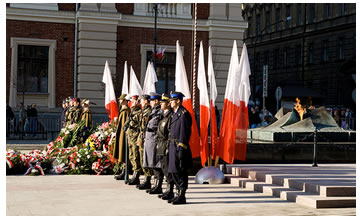
POLISH ADVENT TRADITIONS
In Poland, Advent is a time of fasting and prayer, of spiritual preparation for Christmas. The four weeks of waiting for the Nativity are not a time for parties, decorating, and shopping like in the United States. In Poland, people stay indoors and the long evenings are spent making handmade decorations for the Christmas tree out of straw, paper, and foodstuffs like nuts and grains. It is also a time for making handmade gifts, baking Christmas cookies, and preparing other delicacies for the upcoming holidays. Special early-morning masses called “roraty” are celebrated, starting when it is still dark out, with churchgoers lighting candles at different times during the mass, gradually bringing light to the day and symbolizing the upcoming Nativity of Christ, a miracle that brought light and salvation to the world.
St. Nicholas Day
December 6th, St. Nicholas day – Dzien Swietego Mikolaja – brings a slight reprieve to the gray winter days, especially to children, who feel that Christmas is still so far away. Someone in the family was selected to represent St. Nicholas and he was often driven in a sleigh to the homes in a Polish village. He was dressed in a long white or red robe, wearing a tall headpiece much like a bishop’s miter, a long white flowing beard, and in his hand he held a shepherd’s staff. He rebuked the naughty children and praised the nice ones, listening to them as they recited their catechism and prayers. Then he passed around heart-shaped pierniki (gingerbread cookies), holy pictures, and big red apples, which he produced magically from under his cloak. When St. Nicholas could not make the visit personally, his gifts were placed under the children’s pillows during the night. The tradition continues today, and Polish children receive gifts on December 6th as well as on December 24th.
Roraty
One of the most beautiful traditions of preparing for Christmas in Poland is a mass called “roraty,” that is only celebrated during Advent. The mass begins before sunrise, in complete darkness. The word “roraty” comes from the first words of the introit, the prayer that begins the mass, which are “Rorate coeli” in Latin, meaning “Heaven, drop the morning dew,” and which asks for blessings on the new day that is about to begin.
In no other country is this mass celebrated as solemnly and as beautifully as in Poland. The service symbolizes readiness and vigilance in anticipation of Christ’s coming. People who participate in the service bring torches or candles with them, which are lit at certain times during the mass, gradually dispelling the darkness.
This service has a very special atmosphere since it starts in total darkness, before sunrise, and as daybreak slowly comes, candles are lit at the altar and in the hands of the people participating in the service. As the mass comes to an end, the sun has risen and the world is bathed in light, symbolizing the nativity of Christ which brought light and redemption to the world. Roraty have been celebrated in Poland since the 12th century and continue to be celebrated in cities and villages throughout the country to this day.
Szopki Krakowskie
Krakow, the historic royal city of Poland and former capital, celebrates Advent in a very special way. On the first Sunday of Advent, the beautiful city square “Rynek” gets decorated with fir boughs, garlands, Christmas trees, and twinkling lights. Booths are set up for the Christmas Market and on the first Thursday in December, the square turns into an art competition, keeping alive a tradition that dates back hundreds of years. The competition for the most beautiful Krakow Nativity Crib or ” Szopka Krakowska” is sponsored every year by the Historical Museum of Krakow.
The szopki are richly ornamented, multi-layered, and constructed from colored paper, silver and gold foil, cardboard, bits of plastic, and faux jewels. Actual sizes of the competition nativities range in size from small enough to fit inside a matchbox to several meters high. In keeping with tradition, Krakow szopka-makers often incorporate characters from Krakow history and legends in their creations, such as Queen Wanda, the Dragon of Wawel, and the famed Lajkonik. Each crèche is a miniature version of Krakow, rendered in fairy-tale colors, intricate and joyful, and often imbued with humor. This art form dates back back to medieval times and the competition for the most beautiful Krakow szopka was reinstated in 1937, discontinued during the War years, and reopened again in 1946.
The open-air Christmas market is the backdrop for the competition and there are many booths set up that sell Christmas ornaments and gifts, beads, wooden toys, pottery, lace, nativity scenes, and other handmade gifts. The smell of roasted chestnuts and mulled wine fills the air as lights twinkle illuminating the beautiful buildings and monuments on the Square. It is one of the most beautiful city centers in all of Europe, in every season of the year!
POLISH TRADITIONS – KOLEDNICY-CAROLERS
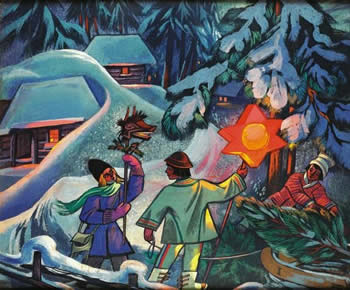
The Polish Christmas season extends from Christmas Day, December 25th, to the Epiphany or Feast Day of the Three Kings on January 6th. This time period encompasses the Twelve Days of Christmas that are still celebrated in many European countries. One of the most beloved traditions of this post-Christmas season in Poland are kolednicy or carolers — groups of children or young men and women, dressed in costumes, who enact the story of the Nativity and sing koledy (Christmas carols) as they go from house to house in the villages and towns of Poland in the days following Christmas.
Kolednicy usually carry a six- or eight-pointed star and wear costumes depicting shepherds, angels, devils, kings, queens, jesters, Mary and Joseph, Herod, the grim reaper, and an historic animal called the turon, or tur, an extinct Polish bison. This animal no longer exists but has continued to live on in the imagination and folklore of Poland, especially in the tradition of the carolers’ enactments. The tur costume is usually the most imposing one in the ensemble, often requiring two people to carry it off. The bison sports a large head and horns and he dances menacingly around the other characters during the performance. The tur is such an integral part of this tradition, that caroling is often called “chodzenie z turoniem” or “walking with the tur.”
In the U.S., carolers sing in the streets or perform in churches and schools before Christmas, but in Poland the singing of carols is not allowed during Advent. The reason for this tradition is that the pre-Christmas season is considered to be a time of reflection and solemn preparation for the birth of Christ, and the joyful celebration of his Nativity happens only after Christmas Day itself. In Poland Christmas pageants, Christmas parties, and caroling are all performed in the twelve days that follow December 25th.
In olden times, carolers would receive refreshments from the people whose homes they visited; today they will receive coins as well as a warm drink and cookies, and sometimes even small gifts. Not only do they sing carols and Christmas ditties, they actually perform mini-plays that show Mary and Joseph being denied shelter in the inns of Bethlehem, Herod trying to find Baby Jesus and kill him before he can become King of the Jews, angels announcing the birth of Jesus to the shepherds keeping watch in the hills, and the Three Kings following the star of Bethlehem to pay tribute to the Messiah. There are many other characters that have roles in these plays—from devils and angels, fighting over the loyalties of the audience, to jesters playing pranks on both the actors and the viewers. Very often these plays have a ribald flavor, but that is in keeping with the age-old tradition. Humor is very much a part of the carolers’ repertoire!
This continues to be a rich and much beloved tradition in Poland, one that goes back hundreds and hundreds of years. Children and teens love to dress up and perform the roles that have been handed down through the generations. And while they have lots of fun doing this, it is important to note that they are carrying on a beautiful age-old Polish custom that they are preserving and preparing to pass on to future generations.
POLISH CHRISTMAS TRADITIONS
Christmas Wafer – Oplatek
Sharing of the oplatek (pronounced opwatek) is the most ancient and beloved of all Polish Christmas traditions. Oplatek is a thin wafer made of flour and water, similar in taste to the hosts that are used for communion during Mass. The Christmas wafer is shared before Wigilia, the Christmas Eve supper. The head of the household usually starts by breaking the wafer with his wife and then continues to share it with everyone at the Wigilia table. Wishes for peace and prosperity are exchanged and even the pets and farm animals are given a piece of oplatek on Christmas Eve. Legend has it that if animals eat oplatek on Christmas Eve, they will be able to speak in human voices at midnight, but only those who are pure of spirit will be able to hear them.
This tradition dates back many centuries when a thin, flat bread called podplomyk was baked over an open flame and then shared with the family gathered around the fire on Christmas Eve. Patterns would be cut onto the bread to make breaking easier. This is why oplatki today still have patterns on them, usually of Nativity scenes. You can order Oplatki from PWA.
Christmas Eve Dinner – Wigilia
Christmas Eve is the most holy and meaningful day of the year in Poland. It is a day of waiting for and celebration of the birth of the Christ Child. Wigilia comes from the Latin word “vigilare” which means to wait. Early in the day, the women of the family start preparing the meal, which traditionally consists of twelve meatless dishes, and includes many kinds of fish, beet or mushroom soup, various dishes made from cabbage, mushrooms, or potatoes, pierogi, followed by dried fruit compote and pastries for dessert.
While the meal is being cooked, the men and children decorate the Christmas tree and set the table. Hay is usually placed in the corners of the room and on the tablecloth, recalling Christ’s humble birth in a stable. An extra place setting is added in memory of those who are not able to join the family for Wigilia. When the first star, gwiazdka, appears in the night sky, the meal can finally begin. A prayer is said first and then the family members share the oplatek and exchange wishes, before sitting down to the meal everyone has been waiting for all year long.
After Wigilia, the family gathers under the tree, choinka, to exchange gifts and sing carols. Shortly before midnight, the family gets ready to go to Midnight Mass called pasterka which means Shepherds’ Mass. When Jesus was born, only humble shepherds came to adore him and to spread the good news.
Christmas Carols – Koledy
The Polish word for Christmas carol is koleda (pronounced kolenda) and it comes from the Latin word “calendae,” meaning the first day of the month. Koledy are mostly anonymous, having been created by the Polish people over the centuries. Koledy date back to the fourteenth and fifteenth centuries and while they did start out as hymns to be sung during Mass, they quickly found their way out of churches to the populace, where they took on a colorful life of their own.
You can hear strains of Polish folk melodies and popular tunes in many koledy. They are tender and humorous as often as they are joyful or exalted. The miraculous story of the birth of Baby Jesus, the Son of God, in a humble stable, surrounded by animals and shepherds, appealed to the popular imagination and resonated with the people, resulting in the creations of hundreds of carols over the years, both religious and humorous, that retell this story in many different ways. Many koledy are regional and not as well-known as the more traditional ones that we sing in our homes today. Poland has a larger cannon of Christmas carols than any other Christian nation.
Carolers are called kolednicy and they walk from house to house between Christmas and the Feast of the Epiphany, carrying a star on a pole and a Nativity scene. They usually wear folk costumes or dress up as angels, shepherds, kings, sometimes also as devils or the Grim Reaper. They enact Nativity plays, often with a touch of comedy added, along with the singing of carols. They are treated to food and drink and sometimes other gifts in return.
The most beloved Polish koledy include “Gdy sie Chrystus rodzi “(When Christ is Born), “Lulajze Jezuniu,” which is a lullaby to Baby Jesus, and “Przybiezeli do Betlejem” (The Shepherds Arrive in Bethlehem).
You can find lyrics of popular Polish Christmas Carols at www.sadurski.com/bozenarodzenie/.
Polish Christmas Tree – Choinka
Christmas in Poland has a different timeframe than an American Christmas. The four weeks before Christmas are not spent on decorating, shopping, and parties, but on the spiritual preparation for the Birth of Christ. Advent is a quiet time, spent in anticipation of the holidays and the miracle of Christmas. Handmade ornaments will be made in the evenings and cookies will be baked, and in recent years, gift shopping and wrapping will take place, but the Christmas tree or choinka will not be brought into the home until a day or two before Christmas.
On Christmas Eve, as the women in the family start to prepare the evening meal, Wigilia, the men and children busy themselves with putting up the Christmas tree and decorating it. Polish Christmas ornaments have a very old tradition. They are often made of blown glass and then painted and decorated by hand, so they are very delicate and need to be handled with care. These glass ornaments, called bombki, have many shapes — some are round, others are shaped like icicles, pine cones, or angels. Other ornaments are made from paper, wood, straw, or hollowed eggs. Fruit, cookies, and candies are sometimes also hung on the tree. At the end, foil icicles and chains made from paper or wooden beads are added, and a large star is placed on top. Small beeswax candles add the final touch. After Wigilia, the candles on the choinka are lit and the family gathers around the tree to open presents and sing Christmas Carols.
The tree will stay up at least through the Twelve Days of Christmas, which end on the Feast of the Three Kings on January 6th, and sometimes it stays up even until February 2nd, which is Candlemas Day and the official end of the Christmas season in the liturgical calendar. So while the Christmas tree comes later into a Polish home, it also stays much longer than it does in an American home. Christmas parties and Christmas pageants are held all through January, so everyone does get to enjoy their choinka – only that it happens after Christmas — rather than before!
Nativity Scene – Szopka
Nativity scenes, popular at Christmas in all Christian countries, originated with St. Francis of Assisi in the 13th century and spread to Poland quickly afterwards. During the Middle Ages, a live nativity scene, enacted by young men, called jaselka, developed in Poland. Some actors told the Christmas story with the help of wooden and cloth puppets — and they often employed lots of humor and exaggeration in their renditions. The tradition continues through today, as young men and women go from house to house in the days after Christmas, carrying a nativity scene called a szopka, and reenacting the Christmas story and singing Christmas carols.
In homes and churches, the movable puppets were replaced over time by smaller wooden figurines that were hand-carved and beautifully decorated. In olden times, the figures included not only the Holy Family, stable animals, shepherds, and angels, but also heroes of Polish history such as winged hussars, knights, queens, and kings, as well as legendary figures such as Pan Twardowski, the Warsaw Mermaid, and the Wawel Dragon. Today, the szopki are mostly religious but the hand-carved figures are still beautifully and lovingly created by artists all over the country who pass their skill down to others, generation after generation.
The city of Krakow has its own very colorful szopka tradition that dates back to the 19th century, when Krakow’s craftsmen, including masons and woodworkers, began to make them as seasonal decorations in order to earn extra income during the holidays. The custom grew in popularity, with people willing to pay to look at szopka collections, which were often carried door-to-door by carolers, or to buy them for their own homes.
Over the years, the city government decided to support this tradition by announcing the first official Krakow Szopka Competition in December 1937. Since then, with the exception of the World War II years, the competition takes place on the first Thursday of December in the Main Market Square in Krakow, next to the Adam Mickiewicz Monument. The winning szopki are later displayed in the Historical Museum of Krakow.
The elaborate structures can be up to six feet high and three feet wide and they often show the many churches and palaces of Krakow that are their inspiration. The building most often replicated is St. Mary’s Basilica with its easily recognizable spires. Other popular buildings that appear in the szopki include Wawel Castle, Sukiennice Hall, and the Barbakan. The humble stable of Bethlehem can often be found on the second floor of the szopka, while the lower floor is filled with historical figures.
If you are ever in Poland in December, be sure to visit Krakow and see some of the szopki displayed in the historic Market Square. Or you can see them at any time of the year in the Historical Museum of Krakow. There is also a beautiful Krakow szopka on display in the PWA Home Office in Chicago.
POLISH WEDDING TRADITIONS
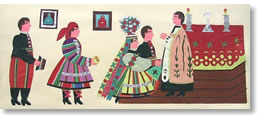
May and June are months of weddings and many Polish American brides like to incorporate some Polish traditions into their own weddings. We often get asked to publish some of the common Polish wedding customs. There are, of course, many different traditions and they vary from region to region and from city to village. Country weddings in Poland are often three-day affairs with all the neighbors as well as family members joining in the festivities. In Polish towns and cities weddings are becoming more elegant and smaller and are being held in hotels and restaurants rather than in the bride’s home.
Regardless of whether the wedding will be large or small, held in a Polish village or an American city, it is undoubtedly the most important celebration in a couple’s lifetime. It is a joyful occasion for both families and for both sets of friends and couples usually go all out in planning the day. They try to add meaning to the festivities by writing their own vows and by adding special traditions from their own families or ethnic backgrounds.
Parents’ Blessing
The “wesele” or wedding in Poland began with the groom arriving with his groomsmen at the house of the bride. They would wait outside while the bridesmaids helped the bride to dress and get ready. Guests would also arrive at the bride’s house shortly before the church ceremony. Musicians would be playing as the guests arrived and everyone waited for the bride to appear. People gathered at the home of the bride in order to accompany the bridal couple to church, but also to witness the blessing and symbolic farewells of the bride with her parents, relatives, and friends. The blessing by the parents was sometimes seen as more meaningful than the church ceremony itself! After the couple received the parents’ blessing, everyone stood in a circle around them as the bride’s mother sprinkled them with holy water. The blessings were so important that if a mother or father had died, the wedding party would stop at the cemetery where the groom or bride prayed at the deceased parent’s grave before going on to church.
The trip to the church took place in various ways, with the bride and groom usually riding in separate wagons. Several wagons pulled by stately horses and filled with guests dressed in their Sunday best and with bouquets of flowers, followed the lead wagon on which a driver stood, cracking his whip for everyone to get out of his way. Behind him were a fiddler and other musicians playing merry tunes. Behind the lead wagon, on horseback, rode the master of ceremonies, the Starosta. Everyone sang: the bridesmaids, the groomsmen, the musicians, as well as the drivers.
During the church ceremony it was expected of the bride to cry. If she didn’t, it was believed that she would be unhappy and cry throughout her married life. After the ceremony, the bride sometimes threw handfuls of straw on the young boys and girls who followed the wedding party. Whoever caught the straw was prophesied to marry before the others. Another belief was that whichever of the bridesmaids touched the bride or her wreath first after the ceremony would marry that same year.
Greeting with Bread and Salt
When the newlyweds, followed by the wedding party and invited guests, finally arrived at the Dom Weselny, the house where the wedding feast would take place, they found the door closed to them. The Starosta (best man or master of ceremonies) would have to sing a song asking for the door to be opened to the young couple. The young couple was most often greeted at the entrance of the house by both sets of parents with bread and salt. Salt had equal footing with bread in all family customs from birth to death. It was believed that salt had the power to heal and cleanse, to uncover evil and thieves, to protect houses against fire, dispel storms and hail, and to drive away evil spirits. In Polish American weddings, the parents of the bride and groom often greet the young couple with bread and salt as they enter the banquet hall where the reception will be held. A loaf of bread and a small ramekin of salt should be placed on a tray covered with a white linen cloth. The bride and groom break off a piece of the bread and dip it in the salt while the parents greet and bless them. A glass of wine is sometimes added to the greeting and the couple take a sip of it as well.
“Oczepiny”
Towards the end of the reception, the most important wedding custom of all takes place: the “Oczepiny” or the Unveiling and Capping Ceremony. It is documented all the way back to the 16th century and represents the rite of passage-from young girl to married woman. All the single women at the reception circle the bride as the maid of honor stands behind her and removes the veil from her head as music is played. A married woman then has the responsibility of pinning a married woman’s “cap” on the head of the bride as all the married women present at the reception form a circle around her. At this moment, the bride is officially considered a married woman! Sometimes after the unveiling, the bride will toss the veil rather than the bouquet to the single women or she will give her veil to the maid of honor. The cap was usually a gift to the bride from her godmother. The cap was reserved for special occasions and worn to church, for folk festivals and weddings, and, at the end of a married woman’s life, she was buried wearing the cap from her wedding day.
The Apron Dance
The Polish Bridal Dance has become an American tradition for the descendants of immigrants from Poland and other Slavic countries. The last dance at a Polish American wedding, before the bride and groom leave, is usually reserved for the bride and is called the “Pani Mloda” or Bridal Dance. It is also sometimes called the Money Dance or the Apron Dance. All the guests at the reception line up for a last chance to dance with the bride and to donate money to the newly wed couple. The money is placed by each guest into an apron, which is held by the bride’s father before dancing with the bride. The Starosta (master of ceremonies) keeps the line moving, allowing everyone only a few spins with the bride before cutting in for the next guest’s chance to dance. After each guest has danced with the bride, she or he receives a drink and a piece of the freshly cut wedding cake.
After the final guest completes his dance with the bride, the groom takes his turn. Then he throws his wallet into the apron, takes his bride and the apron, and they leave together to start their new life!


